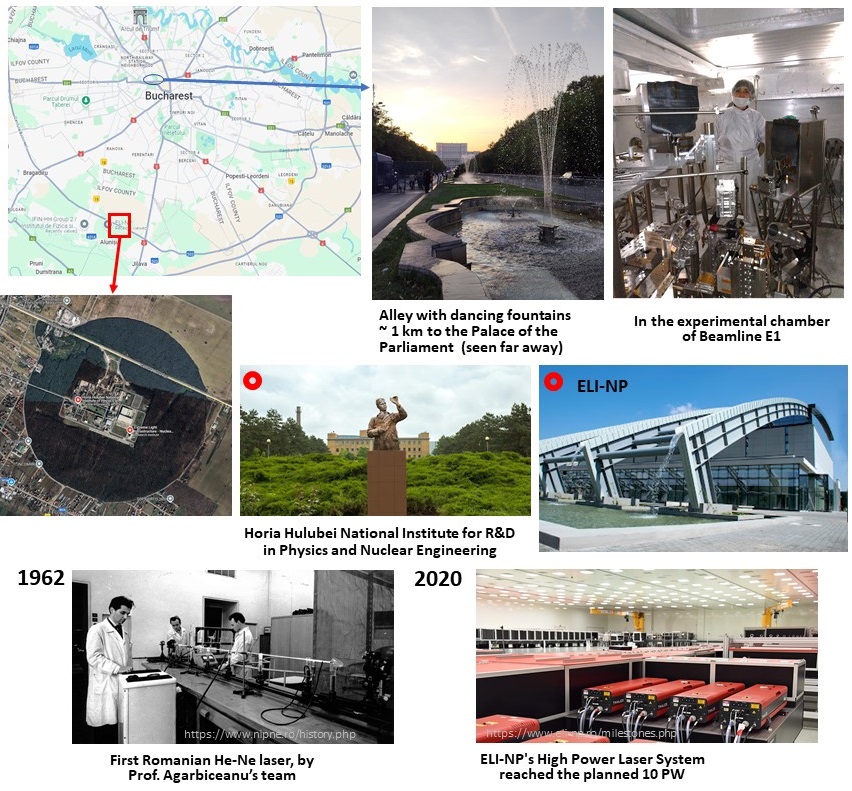出張報告:ルーマニアELI-NP研究所(阪大・PIKUZ, Tatiana)
PIKUZ, Tatiana 先生がルーマニアELI-NP研究所に出張されました。ELI-NPがどのような所か、ELI-NPでの実験の毎日はについてレポートしてくださっています。
If you look at Google Maps’ satellite view south of Bucharest, you will see, among vast agricultural lands and small settlements, an almost perfectly round area covered with green spaces broken into rectangular-shaped areas like a printed circuit board. When you arrive at this place and enter this green oasis, the first thing you will find is that you are surrounded by a dense forest of century-old trees, full of the polyphony of birds. After a few hundred meters, the road will lead you to a guarded gate, behind which there is a gardened ground, buildings in the style of the 50s and 60s and a small monument to a man carefully examining something against the light. That is academician Horia Hulubei, one of the best-known Romanian scientists in atomic and nuclear physics, having Marie Curie as the head of the doctoral committee for his doctorate degree in 1933. He founded the Institute of Physics in Magurelle. The first Romanian computer, cyclotron and fission reactor were put into service here in 1956. In 1962, the first Romanian laser was born here. But we have to go farther and walk along the fence about 1 km to reach another gate. There is a vast parking area on the left, a forest around, a bus stop (buses to Bucharest circulating until 23:30), and an entrance equipped with turnstiles. Few formalities, a badge in hand and you’re there: ELI-NP, the most advanced laser facility in the world in the field of photonuclear physics! If you are at least a bit romantic person, you may imagine that together with your pass from one gate to another, you passed a whole fascinating way from first pioneering He-Ne lasers to a fascinating multi-PW facility.
In September, I visited ELI-NP for the third time and participated in the 10PW laser commissioning experiment for the third time. Together with Dr Y. Fukuda (KPSI QST), we continue working on installing X-ray spectral diagnostics in the experimental chamber of beamline E1. The setup of two spectrometers for the front and back side target observation has been enhanced to extend the available spectral ranges. We have managed to significantly improve the protection of spectrographs from parasitic backgrounds, a serious problem that remained unsolved after previous experiments.
In the laser-target shots, we applied different metal thin-foil targets and measured plasma emission on the dependence of laser contrast (double- or single plasma mirror) and target thickness. After the adjustments were made, the diagnostics worked well. We observed spectra giving interesting data for a better understanding of the role of collision and tunneling ionization processes in plasmas created by laser pulses with intensities exceeding 1022 W/cm2.
To keep the whole experiment going, we had very often to remain in the experimental hall until midnight or 1-2 a.m. I would like to express my admiration for the selfless work of our Romanian colleagues, who, day after day, overcome the inevitable problems accompanying the commissioning setup stage. This especially applies to the experiment’s head, Dr. Domenico Doria, who was always the last to leave the experimental hall and the first the next day, starting the daily morning meeting at 9 a.m.
Finally, the beamtime is coming to an end. One weekend remains before departure. Let’s look at the map again. It is time to go to Bucharest…

